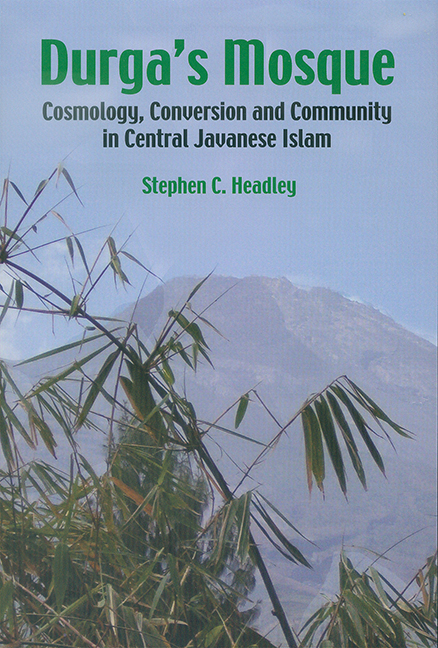Book contents
- Frontmatter
- Contents
- List of Figures
- List of Tables
- Preface
- Acknowledgements
- Introduction: Cosmology, Conversion and Community in Javanese Islam
- PART I THE SOCIOLOGY AND PRACTICE OF RELIGION IN CENTRAL JAVA
- PART II RECONSTRUCTION OF LOCAL RELIGIOUS HISTORY
- PART III INVOKING THE COSMOS, MAGNIFYING ALLAH: STRUCTURING A LANDSCAPE IN THE SEVENTEENTH TO NINETEENTH CENTURIES
- 7 The Khandava Forest in India and Its Javanese Demon Queen
- 8 The Spearing of Durga's Buffalo
- 9 Invoking the Goddess Durga; Worshipping Allah
- 10 The Javanization of Islamic Prayer; The Islamization of Javanese Prayer
- 11 Javanese Cosmologies and Muslim Cosmographies: An Encompassing Knowledge?
- PART IV COSMOLOGY, CONVERSION AND COMMUNITY IN CENTRAL JAVANESE ISLAM TODAY
- Bibliography
- Index
- About the Author
9 - Invoking the Goddess Durga; Worshipping Allah
from PART III - INVOKING THE COSMOS, MAGNIFYING ALLAH: STRUCTURING A LANDSCAPE IN THE SEVENTEENTH TO NINETEENTH CENTURIES
Published online by Cambridge University Press: 21 October 2015
- Frontmatter
- Contents
- List of Figures
- List of Tables
- Preface
- Acknowledgements
- Introduction: Cosmology, Conversion and Community in Javanese Islam
- PART I THE SOCIOLOGY AND PRACTICE OF RELIGION IN CENTRAL JAVA
- PART II RECONSTRUCTION OF LOCAL RELIGIOUS HISTORY
- PART III INVOKING THE COSMOS, MAGNIFYING ALLAH: STRUCTURING A LANDSCAPE IN THE SEVENTEENTH TO NINETEENTH CENTURIES
- 7 The Khandava Forest in India and Its Javanese Demon Queen
- 8 The Spearing of Durga's Buffalo
- 9 Invoking the Goddess Durga; Worshipping Allah
- 10 The Javanization of Islamic Prayer; The Islamization of Javanese Prayer
- 11 Javanese Cosmologies and Muslim Cosmographies: An Encompassing Knowledge?
- PART IV COSMOLOGY, CONVERSION AND COMMUNITY IN CENTRAL JAVANESE ISLAM TODAY
- Bibliography
- Index
- About the Author
Summary
THE CORPUS OF THE MANTRA
The value of studying the different collections of invocation used for Durga in Krendawhana and elsewhere is to see, before this cult became haram (forbidden) for Muslims, the extent to which these prayer had begun to absorb Islamic terminology. Praying at graves of holy men to gain merit (pahala from the Sanskrit phala) is common among Javanese; Muslims and non-Muslim alike “send their prayers” (ngirim donga) in repetitive waves from the foot of the tertre (Pradjarta Dirdjosanjoto 1999, p. 89). However, few people have had access to the collections of mantras used in Krendawahana. The mantra for the maésa lawung, those used for the accession to the throne of the king and the birth of princes and outside the palace for the so-called Birth of Kala or exorcism (ruwatan) of, as well as some protective songs (kidungan), overlap, producing their present patchwork quality. Only the protective songs had some diffusion in the population. The dhalang kept his as heirlooms to be given only to those few puppeteers who were deemed by their masters to be strong enough to perform the exorcisms. In order to perform exorcisms, contemporary dhalang are usually required to be descended through seven or more generations from the court dhalang Panjang Mas or Cremaganda (van Groenendael 1985, pp. 58–65). The maésa lawung mantra were by definition a palace possession. We have seen in the preceding chapter the list of qualifications required to present oneself for the post of abdi dalem juru Suranata.
These mantras are “polyvalent”; they have multiple uses and may be sung on very different occasions. Furthermore there is an important historical dimension in the case of one mantra, the Tata Winanci for it is found in Bali and among the East Javanese Tengger. That having been said, Nancy Smith- Hefner (1992) for the Tengger pembaron ritual of renewal gives a seven-prayer corpus that seems to be older than other known cosmogonies.
The fact that these various mantras used in the buffalo sacrifices to Durga by the Susuhunan or Mangkunagaran palace officials on the anniversaries of coronation, are also used for exorcistic lullabies, and in the wayang purification ceremonies certainly sugggests that they are heterogeneous not only in usage but also probably in origin.
- Type
- Chapter
- Information
- Durga's MosqueCosmology, Conversion and Community in Central Javanese Islam, pp. 330 - 359Publisher: ISEAS–Yusof Ishak InstitutePrint publication year: 2004

